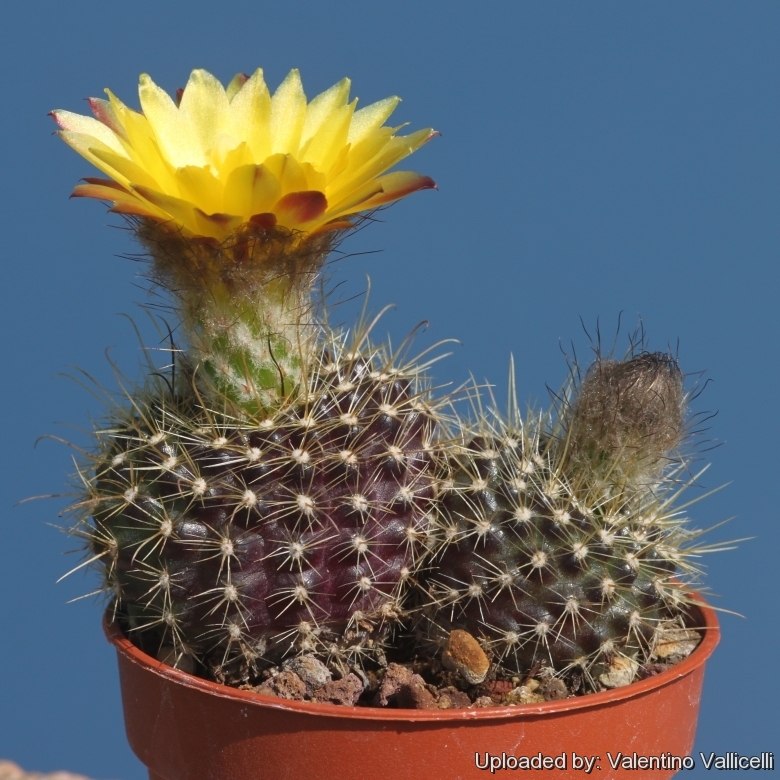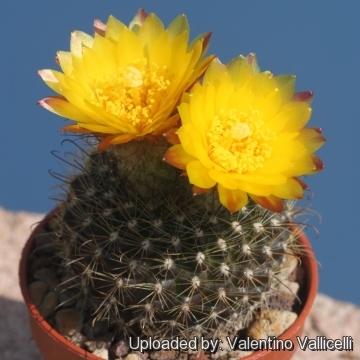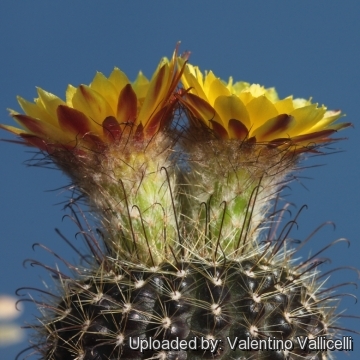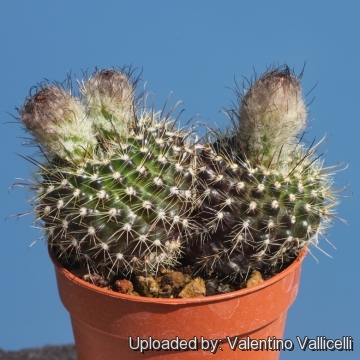
Parodia alacriportana subs. brevihamata Photo by: Valentino Vallicelli
Origin and Habitat: Jaquirana, Rio Grande do Sul, Brazil
Synonyms:
See all synonyms of Parodia alacriportana
Common Names include:
RUSSIAN (Русский): Пародия короткокрючковая
Description: Parodia alacriportanaSN|6122]]SN|6118]] subsp. brevihamata is a petite cactus species with dark stem covered with short hooked spines and showy golden yellow blooms in spring. It one of the several subspecies of the very variable Parodia brevihamataSN|6118]]SN|6122]] which form a complex of related taxon. It distinguish for the more numerous ribs and more closely set areoles. It is still unclear whether this variable complex is one or several species. There is so much variation in spination that most authors choose to lump them together until further studies are done.
Habit: Plants usually solitary but at times forming small clumps.
Stems: Globular to short cylindrical, about 3-5 cm across, but often more in cultivation, dark olive green or brownish green.
Ribs: 24-32 more or less vertical. Tuberculate.
Tubercles: Rounded
Areoles: Closely set, white or yellowish felt-covered.
Spines: Brownish, orange, yellow and white later grey, interlaced with those of adjacent ribs, often forming a brush-like bundle around the stem apex.
Central spines: 4-6 yellow with reddish tips, one somewhat bent or hooked at apex.
Radial spines: About 16 yellowish-white, bristle-like, spreading.
Flowers: Medium size, 26-40 mm long, 35-40 mm wide, golden yellow. Tube with brown wool and a few bristles.
Fruits: Fruit 8-10 mm broad, covered in wool.
Seeds: Helmet-shaped, About 1 mm, broad, black, strongly tuberculate.
Subspecies, varieties, forms and cultivars of plants belonging to the Parodia alacriportana group
Bibliography: Major references and further lectures
1) Edward Anderson “The Cactus family” Timber Press, Incorporated, 2001
2) James Cullen, Sabina G. Knees, H. Suzanne Cubey "The European Garden Flora Flowering Plants: A Manual for the Identification of Plants Cultivated in Europe, Both Out-of-Doors and Under Glass" Cambridge University Press, 11/Aug/2011
3) David R Hunt; Nigel P Taylor; Graham Charles; International Cactaceae Systematics Group. "The New Cactus Lexicon" dh books, 2006Jackie M. Poole, William R. Carr, Dana M. Price, Jason R. Singhurst “Rare plants of Texas: a field guide” Texas A&M University Press, 30/Dec/2007
4) Nathaniel Lord Britton, Joseph Nelson Rose “Cactaceae: Descriptions and Illustrations of Plants of the Cactus Family” Courier Dover Publications, 1963
5) Curt Backeberg “Cactus Lexicon. Enumeratio Diagnostica Cactacearum.” Blandford Press, Poole, 1976.
6) Friedrich Ritter “Kakteen in Südamerika: Ergebnisse meiner 20jährigen Feldforschungen” F. Ritter Selbstverlag, 1979
7) Hans Hecht “BLV-Handbuch der Kakteen” BLV-Verlagsgesellschaft, 1982
8) Marcus Schneck “Cacti” Random House Value Pub, 01/Dec/1992
9) Clive Innes, Charles Glass “Cacti” Portland House, 01/May/1991
 Parodia alacriportana subs. brevihamata Photo by: Valentino Vallicelli
Parodia alacriportana subs. brevihamata Photo by: Valentino Vallicelli Parodia alacriportana subs. brevihamata Photo by: Valentino Vallicelli
Parodia alacriportana subs. brevihamata Photo by: Valentino Vallicelli Parodia alacriportana subs. brevihamata Photo by: Valentino Vallicelli
Parodia alacriportana subs. brevihamata Photo by: Valentino Vallicelli Parodia alacriportana subs. brevihamata Photo by: Valentino Vallicelli
Parodia alacriportana subs. brevihamata Photo by: Valentino VallicelliCultivation and Propagation: It is relatively easy to grow on its own roots.
Soil: Grow it in an open sandy-gritty cactus compost.
Pots: It needs a relatively shallow pot to accommodate its fibrous roots and provide a very good drainage. It may stay in the same pot for many years.
Watering: Water in moderation, it prefer a completely dry place during winter. Mature individuals easily rot and die especially after planting so be extremely cautious with watering. Keep dry in winter or when night temperatures remain below 10° C. Water it less than average if in bigger pots.
Special need: Provide very good ventilation. Nearly all problems occur as a result of overwatering and poor ventilation, especially when weather conditions are dull and cool or very humid.
Fertilization: Feed them once during the growing season with a fertilizer specifically formulated for cactus and succulents (high potash fertilizer with a dilute low nitrogen), including all micro nutrients and trace elements diluted to ½ the strength recommended on the label. They thrive in poor soils and need a limited supplies of fertilizer to avoid the plants developing excess vegetation, which is easily attacked by fungal diseases.
Exposure: It will do its best with lots of sun and become stressed with inadequate light which could result in poor growth and unnatural shape.
Hardiness: It likes warmth (recommended minimum winter temperature 5° C) however plants kept perfectly dry can can survive low temperatures, approx. -5°, but for safe cultivation it is best to avoid freezing temperatures.
Use: This is a good pot plant suited for a non heated green house. It can be also cultivated outdoors in raised beds, terraces if sheltered from winter rain. This cactus continues to be, a particular prize among collectors
Pests & diseases: These cacti may be attractive to a variety of insects, but plants in good condition should be nearly pest-free, particularly if they are grown in a mineral potting-mix, with good exposure and ventilation. Nonetheless, there are several pests to watch for:
- Red spiders: Red spiders may be effectively rubbed up by misting the plants from above.
- Mealy bugs: Mealy bugs occasionally they develop aerial into the new leaves and flowers with disfiguring results, but the worst types develop underground on the roots and are invisible except by their effects.
- Rot: Rot is only a minor problem if the plants are watered and “aired” correctly. If they are not, fungicides won't help all that much.
Propagation: Seeds. The seeds can be sown in pots of fine, well-drained sandy soil, any time during the spring when temperatures are warm. Cover the seeds with a fine layer of grit and water from below with a fungicide to prevent damping off. For the 1-2 weeks cover the pots with a sheet of glass/clear perspex to keep the humidity levels high. Remove the glass and replace it with light shade-cloth and mist once or twice a day for the next two weeks after which most seeds should have germinated. From then on mistings can be reduced to every second and then every third day as the little plants grow.














